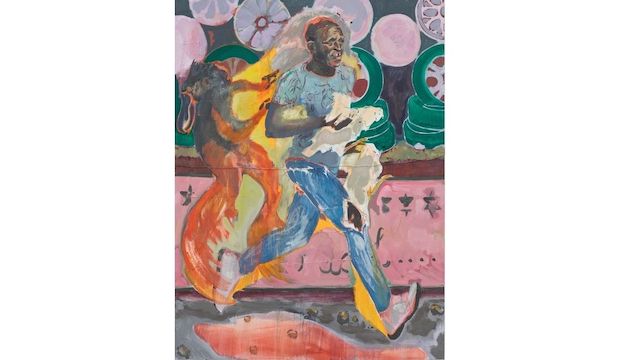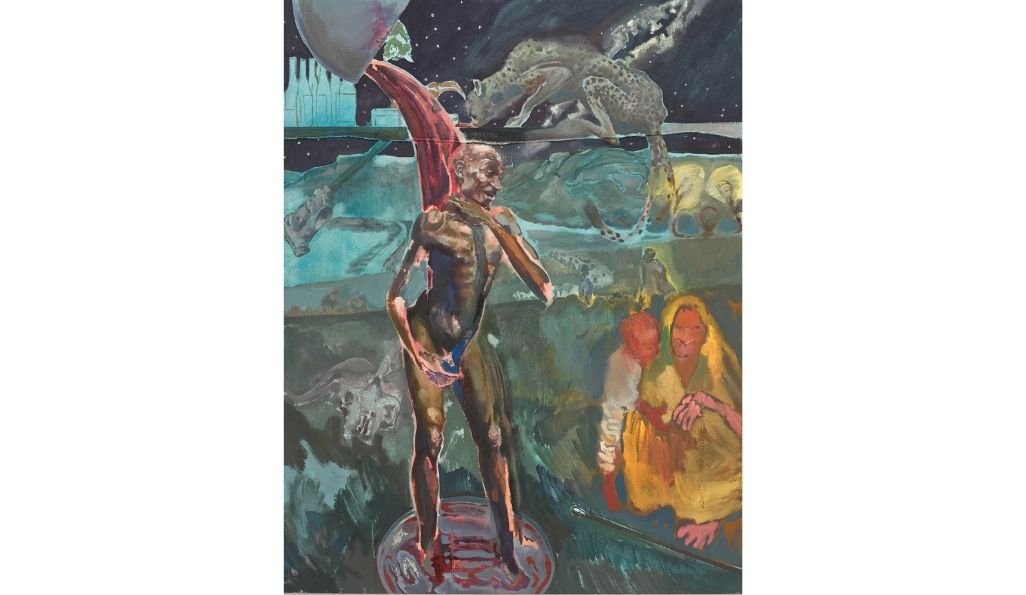Michael Armitage: Paradise Edict exhibition, Royal Academy ★★★★★
Armitage's vibrant paintings fuse African and European traditions in an uncompromising exploration of Kenyan life
Michael Armitage, The Paradise Edict, 2019. The Joyner/Giuffrida Collection ©Michael Armitage. Photo: ©White Cube (Theo Christelis).
An exhibition of riotous paintings has opened at Royal Academy. Brightly coloured and crowded with figures, the works of Kenyan-born artist Michael Armitage (who is a graduate of the Royal Academy) are large scale and dripping with political and social commentary – think Goya meets Gauguin. But while European painting is a powerful source of inspiration for the 37-year-old artist, Armitage, who divides his time between Nairobi and London, is most significantly influenced by the traditions of East Africa.

Michael Armitage, The Chicken Thief, 2019.Courtesy of the Artist and White Cube © Michael Armitage. Photo: © White Cube (Theo Christelis).
The first room of his exhibition explores Kenya’s 2017 national election. In the run-up, Armitage joined a local TV crew, who were filming a rally in Nairobi. His painting The Fourth Estate (2017), depicts a crowd of opposition supporters gathered in and around a sprawling tree. One holds a banner sporting the image of a toad, a symbol of political duplicity.
The next room contains a series of works exploring the complex and layered narratives of Africa’s mythologies and histories. Ghostly forms and hybrid figures, part human, part animal, haunt shimmering landscapes. In an innovative nod to his African roots, Armitage paints on lubugo, a Ugandan material made of bark cloth, which was traditionally used for burial shrouds. By stretching and priming this material, he has transformed it into a canvas and the seams and holes that appear add texture and meaning. One very striking image, titled Antigone, depicts a naked woman. She holds our gaze, her knees pulled up and her legs apart. This painting references the pressures faced by African women to marry and the two very obvious holes in the painting's surface seem a deliberate reference to sex.

Michael Armitage, Mydas, 2019. Oil on Lubugo bark cloth, 220 x 170 cm. Courtesy of the Artist and White Cube © Michael Armitage. Photo: © White Cube (Theo Christelis).
Also included in this exhibition are 35 works by East African artists who have influenced Armitage's artistic development. Kenyan painter Meek Gichugu was one of the first to have an impact on the young painter. Armitage first saw a reproduction of one of Gichugu’s works at a friend’s house when he was nine years old. Speaking to Frieze Magazine last year, he said the painting, which depicts a naked woman entangled in an erotic act with a zebra, ‘acted almost like a trauma to my imagination’. Yet he felt himself compelled to return to it time and time again.
Colourful and thematically dark, strange and absorbing, this is an exhibition well worth visiting. Armitage's career is going from strength to strength. He is represented by White Cube and his works fetch huge sums. So, if you are not yet familiar with his work, this is the ideal opportunity to acquaint yourself with an artist who may well be on his way to becoming a household name.

Michael Armitage, The Chicken Thief, 2019.Courtesy of the Artist and White Cube © Michael Armitage. Photo: © White Cube (Theo Christelis).
The first room of his exhibition explores Kenya’s 2017 national election. In the run-up, Armitage joined a local TV crew, who were filming a rally in Nairobi. His painting The Fourth Estate (2017), depicts a crowd of opposition supporters gathered in and around a sprawling tree. One holds a banner sporting the image of a toad, a symbol of political duplicity.
The next room contains a series of works exploring the complex and layered narratives of Africa’s mythologies and histories. Ghostly forms and hybrid figures, part human, part animal, haunt shimmering landscapes. In an innovative nod to his African roots, Armitage paints on lubugo, a Ugandan material made of bark cloth, which was traditionally used for burial shrouds. By stretching and priming this material, he has transformed it into a canvas and the seams and holes that appear add texture and meaning. One very striking image, titled Antigone, depicts a naked woman. She holds our gaze, her knees pulled up and her legs apart. This painting references the pressures faced by African women to marry and the two very obvious holes in the painting's surface seem a deliberate reference to sex.

Michael Armitage, Mydas, 2019. Oil on Lubugo bark cloth, 220 x 170 cm. Courtesy of the Artist and White Cube © Michael Armitage. Photo: © White Cube (Theo Christelis).
Also included in this exhibition are 35 works by East African artists who have influenced Armitage's artistic development. Kenyan painter Meek Gichugu was one of the first to have an impact on the young painter. Armitage first saw a reproduction of one of Gichugu’s works at a friend’s house when he was nine years old. Speaking to Frieze Magazine last year, he said the painting, which depicts a naked woman entangled in an erotic act with a zebra, ‘acted almost like a trauma to my imagination’. Yet he felt himself compelled to return to it time and time again.
Colourful and thematically dark, strange and absorbing, this is an exhibition well worth visiting. Armitage's career is going from strength to strength. He is represented by White Cube and his works fetch huge sums. So, if you are not yet familiar with his work, this is the ideal opportunity to acquaint yourself with an artist who may well be on his way to becoming a household name.
TRY CULTURE WHISPER
Receive free tickets & insider tips to unlock the best of London — direct to your inbox
| What | Michael Armitage: Paradise Edict exhibition, Royal Academy |
| Where | Royal Academy, Burlington House, Piccadilly, London, W1J 0BD | MAP |
| Nearest tube | Green Park (underground) |
| When |
22 May 21 – 19 Sep 21, 12:00 AM |
| Price | £13+ |
| Website | Click here for more information |